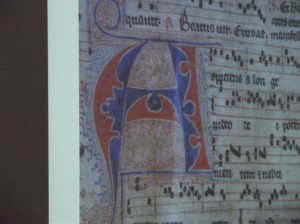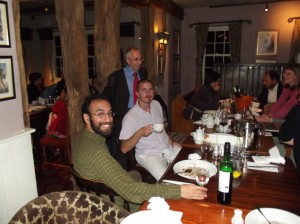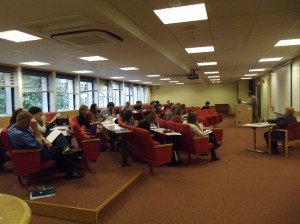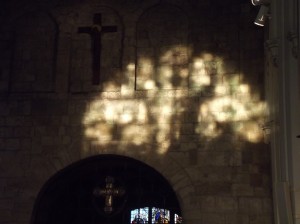Cantum pulcriorem invenire
Postdoctoral researcher Gregorio Bevilacqua finished off the summer with an international conference on medieval music hosted at Southampton. Here he looks back on the highlights:
 I was enjoying the first glimmers of British autumn when we welcomed delegates to Southampton for a three-day conference on the “Gothic” era in the history of Western music. The conference, titled Cantum pulcriorem invenire: Music in Western Europe, 1100-1350 and organised by Mark Everist and me, took place on 9-11 September, and was entirely funded by the AHRC research project Cantum pulcriorem invenire, based at Southampton. I arrived here in 2010 as a postdoctoral researcher on this project, joining a large team that includes postgraduates from England, Italy, Germany, Canada and the USA, whose help was precious during the conference. We brought together 34 scholars of medieval music from Europe and North America, aiming to shed light on the numerous facets of the Ars Antiqua, including the assessment of its sources, historical meaning, and compositional techniques and styles.
I was enjoying the first glimmers of British autumn when we welcomed delegates to Southampton for a three-day conference on the “Gothic” era in the history of Western music. The conference, titled Cantum pulcriorem invenire: Music in Western Europe, 1100-1350 and organised by Mark Everist and me, took place on 9-11 September, and was entirely funded by the AHRC research project Cantum pulcriorem invenire, based at Southampton. I arrived here in 2010 as a postdoctoral researcher on this project, joining a large team that includes postgraduates from England, Italy, Germany, Canada and the USA, whose help was precious during the conference. We brought together 34 scholars of medieval music from Europe and North America, aiming to shed light on the numerous facets of the Ars Antiqua, including the assessment of its sources, historical meaning, and compositional techniques and styles.

People starting trickling in over the weekend; Mark lunched with some of the most enthusiastic on the Sunday, and we met most of the conference participants at the Cowherds that evening (only the French were missing, since the plane from Orly arrived too late for dinner). Lots of drinks, hot food, a warm inn, and friendly conversation anticipated the convivial atmosphere that characterised the whole event, never however diminishing the academic commitment of the dinner partners. Nine sessions of papers focused on a wide range of subjects: the conductus in its multifaceted features, the study of sources, the vernacular tradition of the Ars Antiqua, the motet, its compositional procedures, style, performance and text/music, questions of performance, interpretation, origins, and developments of rhythmic notation.

The quality of the papers was extraordinary, and lively discussions went beyond the time-schedule for all sessions (somehow contributing to my constant – but unnecessary – anxiety!). I especially liked Thomas Payne’s paper on melodic interchanges between syllabic and melismatic sections in the conductus as a structural device, as this is connected to my own work on Librum clausum et signatum. Another highlight for me was the free-rhythm performance of a three-part organum, Alleluia dies sanctificatus, which accompanied Solomon Guhl-Miller’s paper: the question of rhythmic interpretation in historical perspective was fascinating, and it is also most crucial for the conductus repertoire. The atmosphere of the whole conference was extremely friendly and warm, and everyone enjoyed not only the academic excellence of the papers, but also the company of the other delegates during coffee breaks and mealtimes (food in the Nuffield Green Room was attractive, and dinners were lavish). Presenters and attendees were not merely colleagues, but friends sharing the same passion for medieval music.

The conference saw the participation of three world-class singers, John Potter, Christopher O’Gorman, and Rogers Covey-Crump, who contributed to some presentations with their superlative performances. Their concert at St Michael’s, entirely dedicated to the conductus repertoire and eloquently titled Conductus, charmed a good sized and mixed audience, which included not only presenters and attendees but also people from outside the university. The sound of thirteenth-century conducti reverberating in the nave of a twelfth-century church was marvellous.
Cantum pulcriorem invenire was the second in a series of conferences dedicated to the Ars Antiqua (the first was in Princeton in 2011), and plans are already in hand for the publication of the proceedings with Cambridge University Press.

